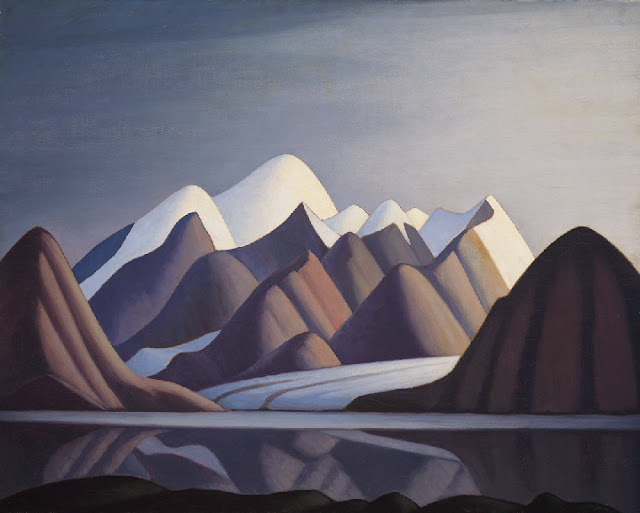Mont Geikie (3,298 m )
Canada (Colombie Britannique)
In Mountain, Tonquin Valley, Jasper, Huile sur toile, 1924 26.7 x 35.6 cm
La montagne
Le mont Geikie (3 298 m)) prononcé comme « geeky » , est un sommet situé dans le parc provincial du mont Robson en Colombie-Britannique, au Canada. Situé à 28 km (17 mi) au sud-ouest de Jasper , près de la vallée de Tonquin, le mont Geikie est le plus haut sommet des Remparts dans les Rocheuses canadiennes, l'une des plus belles chaines de montagnes au monde. Son sommet le plus proche est le mont Frase , à 8,0 km au sud-est, et la ligne de partage des eaux continentales se trouve à 3,0 km à l'est. Le mont Geikie est composé de quartzite de la période cambrienne. Cette roche a été poussée vers l'est et au-dessus d'une roche plus jeune au cours de l' orogenèse du Laramide. La paroi verticale de sa face nord mesure plus de 1 500 mètres de hauteur et a été comparée aux autres grandes faces nord des Rocheuses canadiennes telles que North Twin, Alberta et Kitchener.
Le mont Geikie a été nommé en 1898 par JE McEvoy de la Commission géologique du Canada en l'honneur du géologue écossais Sir Archibald Geikie (1835-1924), qui fut directeur général de la British Geological Survey de 1882 à 190. La montagne a été étiquetée sur la carte topographique de 1911 d' Arthur O. Wheeler de la région du mont Robson. Le nom de la montagne a été officiellement adopté en 1951 après approbation par la Commission de toponymie du Canada . [
La première ascension du mont Geikie a été réalisée en 1924 par Val Fynn, MD Geddes et Cyril G. Wates via une route sud-ouest. La première ascension de la face nord a été réalisée en 1967 par John Hudson et Royal Robbins (classe 5.9 ). D'autres itinéraires sur la face nord incluent le Lowe/Hannibal classe 5.10b ) en 1979 par George Lowe et Dean Hannibal, Hesse-Shilling (5.10) par Mark Hesse et Brad Shilling en août 1994, et Honky Tonquin (VI+ 5.10 A3) par Seth Shaw et Scott Simper en juillet 1999. La première ascension en solo de la face nord a été réalisée en août 2017 par Tony McLane du Canada. La voie d'escalade normale est la Face Sud-Est (IV, 5.5).
Le peintre
Lawren Harris, est un peintre canadien qui a joué un rôle fondamental dans la création du Groupe des sept, ce cercle de jeunes peintres qui allait bouleverser l'art de la peinture au Canada en quelques années.
Après des études à la Central Technical School et au collège St. Andrew, à Toronto, il part étudier à Berlin où il demeurera de 1904 à 1908. Il s'intéresse alors à la philosophie et plus tard à la théosophie.
En 1911, de retour au pays, il se lie d'amitié avec J. E. H. MacDonald. Ensemble, ils fondent le Groupe des sept. Harris devient le théoricien du groupe de par sa formation universitaire. Il défend les idées du poète irlandais George William Russell sur le rôle social de l'artiste. Un local, le Studio Building, procure à ces artistes un endroit pour vivre et travailler. En 1918 et 1919, Harris finance des voyages pour les artistes du groupe dans la région d'Algoma et au lac Supérieur, en Ontario. Séduit par l'endroit, Harris y retourne annuellement durant plusieurs années. Il développe alors le style qui le caractérise le mieux, couleurs vives et riches appliquées en couches épaisses, technique dite impasto. Harris peint également plusieurs paysages de la baie Géorgienne et plus tard des les montagnes Rocheuses.
Lui et plusieurs membres du groupe, dont Alfred Joseph Casson, Arthur Lismer, A. Y. Jackson et Franklin Carmichael feront partie du Canadian Group of Painters.
En 1969, il est reçu compagnon de l'Ordre du Canada.
Il meurt à Vancouver en 1970, où il s'était installé en 1940.
Lawren Harris est considéré comme un des peintres importants du Canada. Plusieurs de ses œuvres ont atteint des prix supérieurs aux estimations, comme en 2001 où sa toile Baffin Island, estimée à 1 million de dollars, a été adjugée pour la somme de 2,2 millions de dollars, ou encore Mountain Forms qui fut adjugé à 11,21 millions de dollars lors d'une vente aux enchères. Cette toile tient à ce jour le record de vente pour une tabelau canadien.
______________________________________
2023 - Gravir les montagnes en peinture
Un blog de Francis Rousseau





%20-The%20Ramparts,%20Tonquin%20Valley,%20Rocky%20Mountains%20Huile%20sur%20panneau27,%201x%2035,%205cm-%20Fondation%20Sobey%20.jpg)













